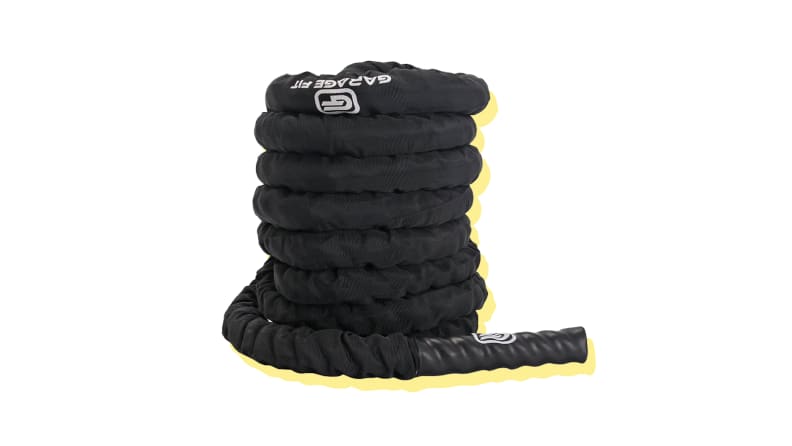Products are chosen independently by our editors. Purchases made through our links may earn us a commission.
If you’re looking for new ways to challenge yourself at the gym, why not try your hand at using battle ropes? While these coils of heavy rope might look intimidating, they can deliver an all-in-one, low-impact cardio and strength workout. Though you’ll likely need a couple sessions to get used to swinging them in a way that delivers results, they aren’t as tricky as they seem to get the hang of. To get a great workout using battle ropes, check out these pro tips.
What are battle ropes?
You’ve probably seen fellow gym goers whipping them around with a loud thunk against the floor. Battle ropes—also called battling ropes, muscle ropes, exercise ropes, or heavy ropes—are often made of twisted fibers of flexible plastic called poly Dacron to give them their weight and high-tensile strength, and they’re typically used in CrossFit or HIIT workouts. Battle ropes can also be made of manila, a hemp derivative, though those tend to be more expensive and shed fibers when they pound the ground, so are better suited for outdoor use.
Battle ropes are sold in different lengths and thicknesses to accommodate different workout goals and body types. They typically measure 1½ or 2 inches in diameter and can be 30, 40, or 50 feet long, meaning once you anchor the center of the rope, you’ll need to allocate 15 to 25 feet of distance from the anchor to where you’ll stand while using them. Depending on the thickness and length of the rope, battle ropes can weigh anywhere from 15 to 50 pounds, allowing athletes with various fitness abilities to feel confident using them.
“[As] they can weigh up to 50 pounds, [that] means that as you move each end of the ropes, you’re putting 25 pounds of force into the rope, says Matt Scarfo, a New York City-based personal trainer. “You might not think about doing dozens or hundreds of bicep curls with 25 pounds, but as you do long sets with the ropes, you eventually do just that.”
What muscle groups do battle ropes work?
Battle ropes offer various benefits that make them a good fit for different types of workouts, including both cardio and strength training. “The key benefit of using battle ropes is that they’re an efficient blend of strength and cardio exercise,” says Scarfo. “You can get an upper-body workout that works the biceps, triceps, shoulders, and forearms by putting small waves in the ropes or get a full-body workout by lifting the ends and slamming them down to put larger waves in the ropes.”
In addition to working your biceps, triceps, and upper back, the effort you exert from moving the battle ropes is a surefire way to elevate your heart rate quickly, making it a great component of a HIIT routine or a quick way to get your heart pumping before or after a strength training session.
How do you use battle ropes?
While picking up battle ropes can be beneficial at any point during your workout, they’re particularly great for a burnout—an exercise performed until you reach exhaustion—at the end of any gym session. Scarfo recommends challenging yourself to complete two or three bursts of activity with the ropes at the end of your workout, resting for a minute between them. Aim for a minute for your first one, though it’s possible that you may fatigue before the time is up. If this is the case, continue with the additional sets, but try to match or beat the length of time you were previously able to complete.
Depending on where you want to build strength, you can focus on using only your arms to swing the ropes—one at a time or both at the same time—as a battling rope exercise to tire your upper body. Or you can use the momentum of your full body weight to move the ropes side to side, which will recruit your core and legs for a total body effort.
To position yourself to use the ropes, place your feet shoulder-width apart and bend your knees into a quarter-squat position, butt slightly back and so your knees are not extending past your toes. Pick up an end of the ropes in each hand and hold them an arm’s length away from your body with your hands also shoulder-width apart—there should be some slack in the rope so most of it is resting on the ground. Tighten your core and raise your arms up then down explosively, creating battling rope waves that travel across the floor and back. It may take a few swings to get the rhythm of it.
Begin by using the ropes once a week, with the goal of working your way up to two or three sessions a week as you gain endurance and feel comfortable pushing yourself. Once you familiarize yourself with the up-and-down motion, you can progress to moving the ropes side to side to engage your core, back, and hips. To work those muscles most efficiently, hold your hands closer together than shoulder-width and bring the ropes up over your head and down on one side of your body as you lunge in that direction. Repeat this motion in the other direction, keeping your athletic stance and engaged core.
How can you prevent injury while using battle ropes?
While you put yourself at risk for injury during any type of exercise, battle ropes are a fairly low-risk workout. “The risk can be rather limited with battle ropes because you’re usually doing a lot of stabilizing with your core throughout the workout, keeping your back in good alignment,” says Scarfo.
However, using your entire body to make waves with the ropes puts you at risk for lower back injuries. If you’re concerned about this, reach for the ropes early in your workout to ward off injuries to already-fatigued muscles, says Scarfo. If you have sensitive hands and want to avoid calluses (or just want to improve your grip), don a pair of weightlifting gloves before you grab the ropes.
Where can you buy battle ropes?

Battle ropes can easily be found online.
You’ll need plenty of room to use them in your home gym, but if you have the space, battle ropes are easy enough to find online. The Garage Fit battle ropes are a well reviewed option available on Amazon with 4.8 stars and more than 800 reviews. You can select from options ranging from 30 to 50 feet weighing 15 to 50 pounds, so you’re sure to find a rope that fits in your space and suits your fitness level. Reviewers say they hold up well throughout battle ropes workouts, as they come with a protective fabric sleeve made of a durable polyester blend along their length to avoid fraying.Shop at Amazon
A strong anchor point will allow you to move the ropes in a fast, fluid motion and get the most out of each session. You can wrap them around a pole in your gym, such as the one on your squat rack or even a support column for your home—assuming you have enough space indoors to fully extend the ropes—or around a tree outside. You can also use the handle of a heavy kettlebell (aim for 50-plus pounds) with a few sandbags thrown on top. If you don’t have any of these options, you can buy an anchor and install it into the wall.
The product experts at Reviewed have all your shopping needs covered. Follow Reviewed on Facebook, Twitter, Instagram, TikTok, or Flipboard for the latest deals, product reviews, and more.
Prices were accurate at the time this article was published but may change over time.


